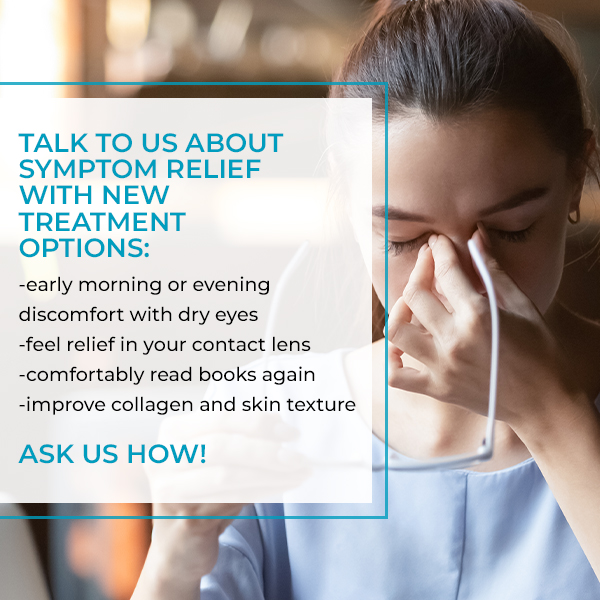If you ever wonder why your eyes seem dry and itchy all the time, you may be dealing with chronic dry eye disease—also known simply as dry eye. It’s easy to recognize most symptoms of dry eye, in most cases. However, a comprehensive eye exam is the best way for the eye doctor to figure out what’s causing the symptoms.
Below, we are looking at what dry eye is and its common symptoms. We’ll also explore a few types of dry eye, each of which has different causes or reasons for affecting us.
What Is Dry Eye?
You may have already guessed it, but dry eye is prevalent and affects millions of Americans annually. Many of these cases are seasonal or situational. However, many people suffer from chronic dry eye symptoms.
Put simply, when you have dry eye—seasonal or chronic—your eyes do not stay lubricated for several reasons, which we’ll look at below. When the eyes don’t stay wet, the result is dry eye’s irritating and painful symptoms.
It’s worth mentioning the importance of treating dry eye. It may not necessarily require emergency intervention, but there is the potential for complications if left unchecked.
Symptoms of Dry Eye
The symptoms you experience may vary depending on the type and cause of your dry eye, but some of the most common symptoms include:
- Feeling like something, such as sand, is in your eye
- Stinging or burning sensations
- Red, bloodshot eyes
- Light sensitivity
- Excessively watery eyes (even though that seems counterintuitive)
- Blurry vision
- Stringy mucus discharge around eyes
- Trouble driving at night
- Discomfort when wearing contacts.
Risk Factors for Dry Eye
Some things put us at a higher risk of experiencing these uncomfortable symptoms. Even making minor changes can have a significant impact on whether you get dry eyes or not.
Some of the common risk factors for getting dry eye include:
- Age
- Medical conditions, such as Sjorgen’s syndrome, lupus, thyroid disorders, vitamin A deficiency, or allergies
- Damage from improper use of contact lenses
- Certain medications, such as antidepressants, acne, birth control, antihistamines, or blood pressure medicine
- Meibomian gland dysfunction (MGD)
- Inadequate amount of blinking, like when spending extended time on computers or digital screens
- Eye drop preservatives
- Environmental things, like wind, smoke, or dry air
Complications of Dry Eye
While not typically critically dangerous, there are several complications that can come from untreated dry eye, including:
- Increased chance of infection: Because our tears are vital in protecting the eye’s surface, when tear quality is compromised, the risk of ocular infections goes up.
- Chance of surface damage: Without the tears to properly lubricate the eyelid and eye, abrasive damage can take place when you blink.
- Poor quality of life: Even if nothing “terrible” happens from your dry eye, the overall quality of life suffers due to discomfort and even not being able to see very well.
Types of Dry Eye
There are three main types of dry eye: Aqueous Deficient Dry Eye, Evaporative Dry Eye, and Mixed Dry Eye. Each of them is differentiated by the root cause of the symptoms.
Aqueous Deficient Dry Eye (ADDE)
Think of ADDE as dry eye symptoms caused by a lack of water or tears for eye lubrication. The lacrimal glands are responsible for producing the water portion of your tears. And if these glands malfunction, they may not create the proper mixture.
Without the proper water content in your tears, they may not lubricate your ocular surface enough. This can cause uncomfortable friction as you blink.
Sjogren’s syndrome is an autoimmune disorder that commonly results in dry eyes—along with a dry mouth and general body dryness.
Evaporative Dry Eye (EDE)
If EDE is the cause of your dry eyes, then the issue lies with a lack of oil in your tears. Generally, this is a common result when MGD is a problem. These glands are responsible for producing the oil that mixes in your tears.
EDE can result from either an inadequate amount of oil or a poor quality oil produced by the meibomian glands. This is one of the most common forms of dry eye.
Mixed Dry Eye (MDE)
In some cases, your dry eye may be a combination of a lack of water and oil in your tears. This is called MDE. An eye examination is the only accurate way to determine if your symptoms result from both.
Treating Dry Eye
There is no one-size-fits-all treatment for dry eye therapy because treatment is mainly determined by the cause. Another thing worth noting regarding treatment is that it’s mostly symptom management.
Common dry eye treatments include:
- Therapeutic drops—either lubricating eye drops or special eye drops to increase natural tear production
- Special types of contact lenses
- Inserts that mimic the eye’s natural tear production
- Opti Light by Lumenis
- Eyelid scrubbing
- Punctal plugs
Explore Your Treatment Options in Daniel Island, Charleston
Often the first line of treatment will be lubricating eye drops—preferably preservative free if used long-term. However, the only way that an eye doctor can recommend the best treatment is by first examining your eyes.
If you’re experiencing any of the uncomfortable symptoms above, give our office a call. The professional staff at Daniel Island Eye Care are available to answer your questions and book you an appointment with one of our eye doctors.





